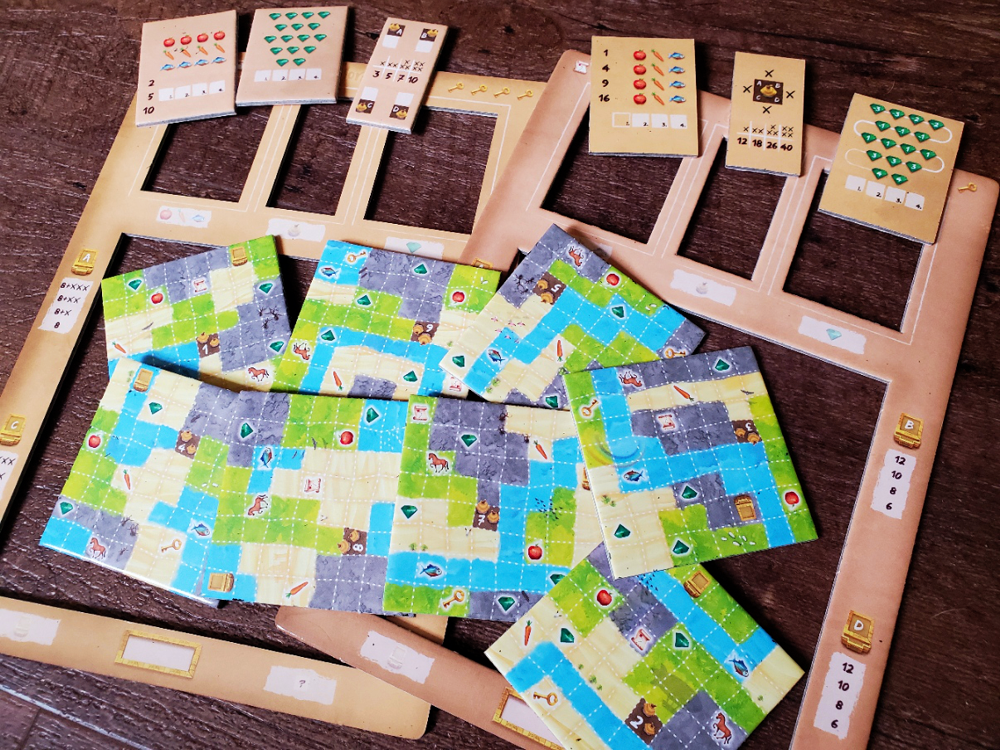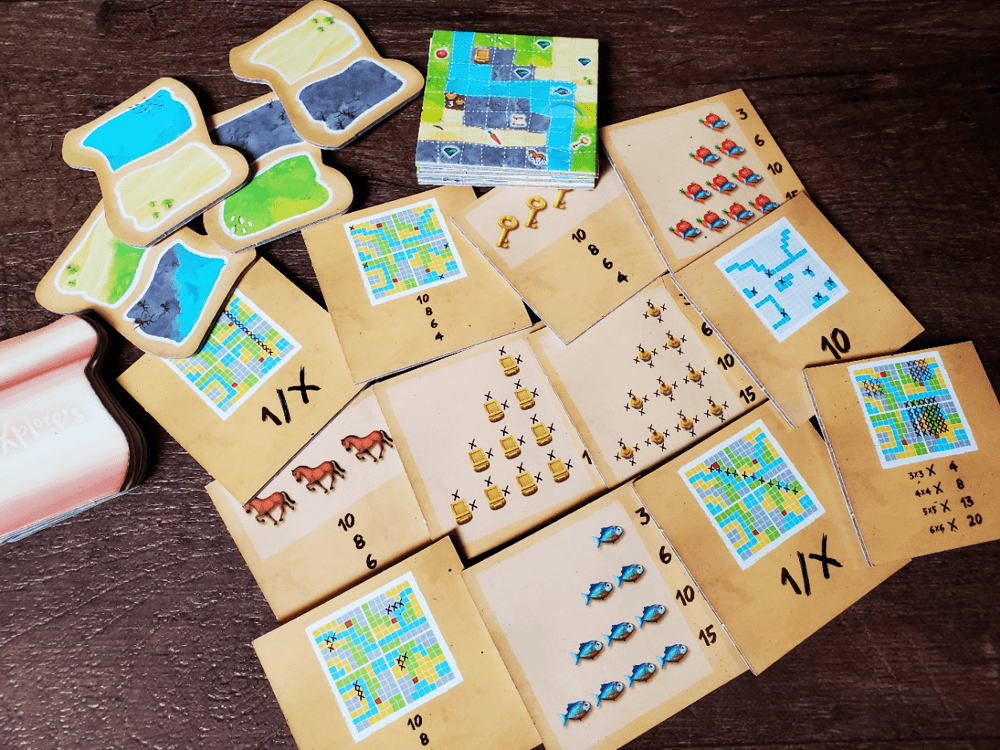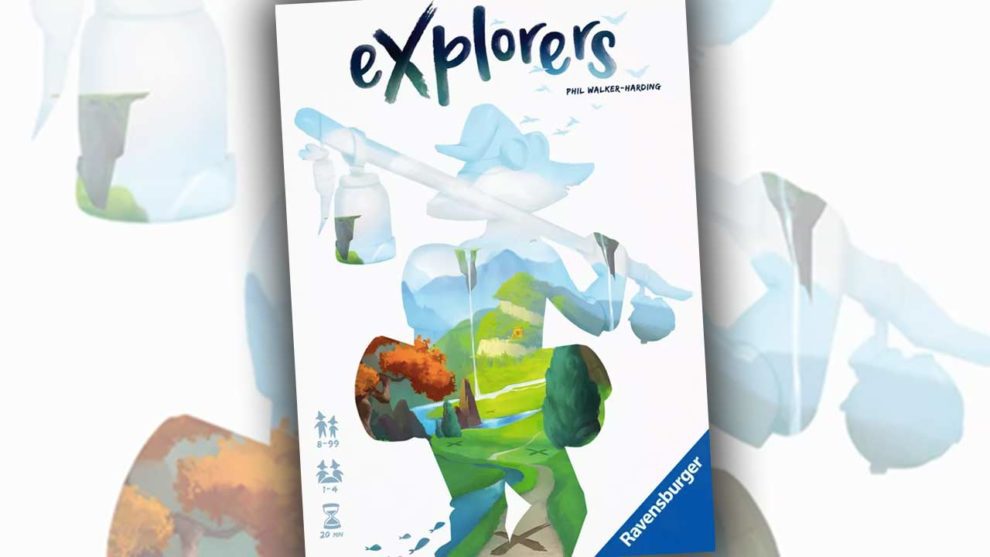A few months ago, while visiting with family, I sat down to a game of Explorers from publisher Ravensburger and master mechanical distiller Phil Walker-Harding. I had not heard of the 2021 release prior to that play, but it was good. Phil Walker-Harding titles are reliably good. Our next visit has now been peppered with repeated plays of this easy flip and write.
The gridded map consists of four of the eight included 8×8 tiles dropped uniformly into each player’s dry-erase frame as quadrants. Each tile contains roughly the same number of sand, grass, stone, and water squares laid out in unique patterns. Each tile also contains one each of a village, key, temple, horse, scroll, gem, apple, carrot, and fish.

Across four rounds, players take turns pulling tiles from a stack of seven. Each tile has two terrain options. The active player selects one, marking three X’s on matching terrain squares of the map, each orthogonally adjacent to a previously placed X. The inactive players choose either two X’s to match the active player’s selection or three X’s of the other. Every item that receives an X is marked somehow to match the scoring conditions employed for the game. There are a few items to score between rounds before totals are determined at the end.

Food items are collected in sets. Villages score by dropping X’s in the four surrounding cardinal direction squares (while never actually passing through the town—that’s just mean, Phil). Gem scoring compounds from round to round. Temples unleash points or maybe bonus X’s, but visitation first requires a key. Horses grant an immediate bonus X. Scrolls can replace any turn with four X’s of a single terrain type. Just place the X’s legally so as not to draw unwanted attention.
That’s it. And yet, there’s a whole lot of game in this small box.
Because each game employs only four of the eight map tiles, and each tile might be rotated in any of four configurations, the map is hardly (if ever) the same. Because each round includes only seven of the eight shuffled terrain tiles, the tiles hardly (if ever) come out the same. Because there are reversible tiles to determine scoring options for food, villages, and gems, the exact motivations are constantly shifting. The entire player board is reversible to introduce a different bonus for scoring temples. Because there are humans involved, the resulting navigations are all over the map. In other words, the decision space easily stays fresh through endless possibilities in the setup.

Once the base mechanics make sense and the setup has been adequately tinkered with, there is one lingering monkey wrench in the box. The back of each map tile displays a possible scoring condition. How many apples can you collect? Who can be the first to collect all four keys or complete a straight line of X’s across the map? Include one, two, or even three of these tiles to tug the mind in several additional directions. Because, why not?!
My favorite superfluous feature is the image of a completed game board printed inside the bottom of the box. Phil scored a 90—respectable. This game board subtly answers so many of the possible questions about the game. Do I mark villages? Well Phil didn’t (except for the starting square). How do I mark my board when others get to the temple first? Well Phill just crossed off the bonuses he didn’t get. How does that advanced food tile work? Well it appears Phil collected the foods marked for each round. It just works. It’s brilliant. Everything is scored and traceable.

Explorers is a clean family play. The five-year-old loves it, and the simultaneous play kept her at the table the whole time, every time. The nine-year-old loves it. Dad loves that every decision impacts everyone at the table without much malice. Even as we attempted the advanced options, everyone kept up because the strategy only ever shifts a few degrees in one direction or another. Surrounding those villages is a stretch for the young’uns, but otherwise the whole system is more than manageable. It’s easy to add variety to mask an ill developed game, but in this case the mechanics are so cleanly assembled the variety just means every exploration strikes a different harmonic note.
As for the actual selling point, Explorers is $20 from most retail shops. If you regularly have more than four players, just buy two copies so everyone can jump in. It’s 30-60 minutes (kid-pacing wrecks the 20-minute suggestion on the box) of breezy, nonstop engagement with several available layers of complexity. Ravensburger has an easy recommendation here, especially if you’re into dry-erase markers, glossy tiles, and the speckless wonder of a white box and that Phil Walker-Harding vibe.
If you enjoy Explorers, then make sure to check out another one of Phil’s “dry-erase adventures”, Silver & Gold.












Add Comment